Ahh Burnt - thanks for that Pedrick info - love it - what a loss to mankind !Slightly off topic but irresistible,
“Arthur Paul Pedrick (3 September 1918 – 15 August 1976)[1] was a prolific British inventor who filed for 162 United Kingdom patents between 1962 and his death in 1976[2] or 1977.[3] His inventions were notable for their humour and almost complete lack of practical applicability.”
My favourite was his invention for irrigating the Australian desert by firing snowballs at the outback from Antarctica. He was granted the patent.
Back on topic @Eucyblues99 I would also like to learn more about your intriguing design
Burnt
Viridian - OK - Not sure how deep to go into this - but started with thinking somewhat outside the square.
I wanted to see if I could induce vibrations in a back panel by using a resilient curved mount on either side, so I stated with small trial pieces and was encouraged to go further. The aim was to reinforce the front panel output, to get a bigger panel area from a smaller footprint, to get the vibrations to 'turn the corner' so to speak. Of course, there is also the effect of the back waves energising the rear panel so it's hard to know the extent to which each mode contributes.
However, there was a distinctive audible effect in deeper mids and lows so I persevered. The rest involved tuning out negative effects of reflected waves, tunnel effects, etc etc.
What you see is the result of many, many hours of testing, listening, modifying, and repeated test builds.
Basically, the panels are supported along each edge with a 60mm resilient (springy) half tube, damped side, top, bottom and rear ports and are provided. Is this the right size/separation - I don't know - there's a limit to the amount of experimenting a single person can do, (and that's where this forum could be more useful).
The front and rear panel size is 900x300 mm - 3mm poplar ply - each selectively stiffened with light bracing, and treated with Shellac.
The front panel is driven by a single Dayton Audio DAEX25SHF-4 exciter, (with my 'Eucydome' of course). A DAEX32ep-4 thruster is attached to the lower portion of the rear panel in reverse phase, and has been used in both subwoofer and full range modes. In subwoofer mode it gives a moderate boost in the 50-60Hz range, but that I believe is mainly down to the poor subwoofer output of the Fosi amp unit I'm using.
More work needs to be done in the full range mode to prevent interference. (I'm not a fan of the Thruster really.)
Comparing to a single panel of the same size - chalk and cheese imo - can't say any more.
Still needs bass boost on the amp but I usually listen to it without the rear exciter engaged.
I demonstrate them to friends by rotating them - there's no audible difference between face on, edge on or reversed.
The house I've just moved into has a media room with wall mounted speakers and when listening to a stereo source, the difference in the sound stage is quite marked. With closed eyes, the 3 way stage is quite narrow, esp in the vocals, but opens up a lot when the panels are switched in.
Very happy overall - not sure where to go from here at the moment.. too many conflicting demands but the concept I feel is sound (no pun intended) , free standing, small footprint, DML spacialisation.
I'll mull on it over time.
BTW, the speakers in the rear of the photos are hybrids - western red cedar panels, 1200x400x4mm with mast mounts (3 point mounting), each with a DAEX25SHF-4 exciter and 8" down firing woofers in an MDF box with constrained layer damping.
Cheers
Eucy
And, the jewel,

the bass-pump, and the explanation...

Anyway, one might notice in Stanley R Rich's 1962 patent, a "bass-pump". Maybe, we can simply stick an exciter(s) on the back of that flat panel(45) and change the panel's treatment.

Interestingly, all the companies that still build DM loudspeakers, make all their DM loudspeakers in boxes, and/or fix them in walls, ceilings, such as Tectonic, Amina Sound, Cerasonar etc.
the bass-pump, and the explanation...
Anyway, one might notice in Stanley R Rich's 1962 patent, a "bass-pump". Maybe, we can simply stick an exciter(s) on the back of that flat panel(45) and change the panel's treatment.
Interestingly, all the companies that still build DM loudspeakers, make all their DM loudspeakers in boxes, and/or fix them in walls, ceilings, such as Tectonic, Amina Sound, Cerasonar etc.
Last edited:
Excellent lateral thinking, well done! I would love to hear them whenever you are ready to share a recording.Ahh Burnt - thanks for that Pedrick info - love it - what a loss to mankind !
Viridian - OK - Not sure how deep to go into this - but started with thinking somewhat outside the square.
I wanted to see if I could induce vibrations in a back panel by using a resilient curved mount on either side, so I stated with small trial pieces and was encouraged to go further. The aim was to reinforce the front panel output, to get a bigger panel area from a smaller footprint, to get the vibrations to 'turn the corner' so to speak. Of course, there is also the effect of the back waves energising the rear panel so it's hard to know the extent to which each mode contributes.
However, there was a distinctive audible effect in deeper mids and lows so I persevered. The rest involved tuning out negative effects of reflected waves, tunnel effects, etc etc.
What you see is the result of many, many hours of testing, listening, modifying, and repeated test builds.
Basically, the panels are supported along each edge with a 60mm resilient (springy) half tube, damped side, top, bottom and rear ports and are provided. Is this the right size/separation - I don't know - there's a limit to the amount of experimenting a single person can do, (and that's where this forum could be more useful).
The front and rear panel size is 900x300 mm - 3mm poplar ply - each selectively stiffened with light bracing, and treated with Shellac.
The front panel is driven by a single Dayton Audio DAEX25SHF-4 exciter, (with my 'Eucydome' of course). A DAEX32ep-4 thruster is attached to the lower portion of the rear panel in reverse phase, and has been used in both subwoofer and full range modes. In subwoofer mode it gives a moderate boost in the 50-60Hz range, but that I believe is mainly down to the poor subwoofer output of the Fosi amp unit I'm using.
More work needs to be done in the full range mode to prevent interference. (I'm not a fan of the Thruster really.)
Comparing to a single panel of the same size - chalk and cheese imo - can't say any more.
Still needs bass boost on the amp but I usually listen to it without the rear exciter engaged.
I demonstrate them to friends by rotating them - there's no audible difference between face on, edge on or reversed.
The house I've just moved into has a media room with wall mounted speakers and when listening to a stereo source, the difference in the sound stage is quite marked. With closed eyes, the 3 way stage is quite narrow, esp in the vocals, but opens up a lot when the panels are switched in.
Very happy overall - not sure where to go from here at the moment.. too many conflicting demands but the concept I feel is sound (no pun intended) , free standing, small footprint, DML spacialisation.
I'll mull on it over time.
BTW, the speakers in the rear of the photos are hybrids - western red cedar panels, 1200x400x4mm with mast mounts (3 point mounting), each with a DAEX25SHF-4 exciter and 8" down firing woofers in an MDF box with constrained layer damping.
Cheers
Eucy
Burnt
Regarding NXT patents, for examople, Firouz Henry Azima, Neil Harris, Christien Ellis, Andrew Marchant were engineers, Dr. Graham Bank, Neil John Harris, are scientists and engineers.
Eucy.
The sound of the ply panel is fine.
The first picture is of the in room response at about 10ft from my seating position.
This panel suffers from the usual dip in the response below the 300hz region to about 100hz where the panels usually have the low frequency hump down to about 40hz.
I use my TLs to fill in this area.
This is a single point measurement.
I noticed a 10k sibilance on some female vocals and decided to measure the sibilance .
The second picture is the response of my voice making ssssss and shhhhh sounds.
It spans from 2.5k to 20k.
any panel that has a resonant spike in this area will cause problems exaggerating sibilance, sometimes painfully.
This panel seems ok.
The pictures will be in a separate post.
Steve.
The sound of the ply panel is fine.
The first picture is of the in room response at about 10ft from my seating position.
This panel suffers from the usual dip in the response below the 300hz region to about 100hz where the panels usually have the low frequency hump down to about 40hz.
I use my TLs to fill in this area.
This is a single point measurement.
I noticed a 10k sibilance on some female vocals and decided to measure the sibilance .
The second picture is the response of my voice making ssssss and shhhhh sounds.
It spans from 2.5k to 20k.
any panel that has a resonant spike in this area will cause problems exaggerating sibilance, sometimes painfully.
This panel seems ok.
The pictures will be in a separate post.
Steve.
In the side tubes, you have 4 rectangular holes on each side. Are they for bass-reflex? If so, is there a way to close the holes on one side (#8,733) temporarily to check how the sound reacts to that? Also, have you put any damping on the back wall? The springy half tube might be a problem, even though it looks stunning.Enter Concept 2-Viridian....
The tube also plays as a curved DM panel. In a way, you have two large DM panels, and two curved DM panels. Also, what if you turn off the back panel thruster, and block that panel's movements?
Just thinking, if you are not going to place the Viridian in the centre of the room, you don't really need the back panel as a DM panel. More or less, you'd want it silent. In a way, your creation doesn't have a single stiff section/part to hold the other DM parts, that is, if you don't have a structure inside holding everything. Just tinking.
What is that program you are using to measure audio response? With what are you recording for that?Pics
Hello EucyAhh Burnt - thanks for that Pedrick info - love it - what a loss to mankind !
Viridian - OK - Not sure how deep to go into this - but started with thinking somewhat outside the square.
I wanted to see if I could induce vibrations in a back panel by using a resilient curved mount on either side, so I stated with small trial pieces and was encouraged to go further. The aim was to reinforce the front panel output, to get a bigger panel area from a smaller footprint, to get the vibrations to 'turn the corner' so to speak. Of course, there is also the effect of the back waves energising the rear panel so it's hard to know the extent to which each mode contributes.
However, there was a distinctive audible effect in deeper mids and lows so I persevered. The rest involved tuning out negative effects of reflected waves, tunnel effects, etc etc.
What you see is the result of many, many hours of testing, listening, modifying, and repeated test builds.
Basically, the panels are supported along each edge with a 60mm resilient (springy) half tube, damped side, top, bottom and rear ports and are provided. Is this the right size/separation - I don't know - there's a limit to the amount of experimenting a single person can do, (and that's where this forum could be more useful).
The front and rear panel size is 900x300 mm - 3mm poplar ply - each selectively stiffened with light bracing, and treated with Shellac.
The front panel is driven by a single Dayton Audio DAEX25SHF-4 exciter, (with my 'Eucydome' of course). A DAEX32ep-4 thruster is attached to the lower portion of the rear panel in reverse phase, and has been used in both subwoofer and full range modes. In subwoofer mode it gives a moderate boost in the 50-60Hz range, but that I believe is mainly down to the poor subwoofer output of the Fosi amp unit I'm using.
More work needs to be done in the full range mode to prevent interference. (I'm not a fan of the Thruster really.)
Comparing to a single panel of the same size - chalk and cheese imo - can't say any more.
Still needs bass boost on the amp but I usually listen to it without the rear exciter engaged.
I demonstrate them to friends by rotating them - there's no audible difference between face on, edge on or reversed.
The house I've just moved into has a media room with wall mounted speakers and when listening to a stereo source, the difference in the sound stage is quite marked. With closed eyes, the 3 way stage is quite narrow, esp in the vocals, but opens up a lot when the panels are switched in.
Very happy overall - not sure where to go from here at the moment.. too many conflicting demands but the concept I feel is sound (no pun intended) , free standing, small footprint, DML spacialisation.
I'll mull on it over time.
BTW, the speakers in the rear of the photos are hybrids - western red cedar panels, 1200x400x4mm with mast mounts (3 point mounting), each with a DAEX25SHF-4 exciter and 8" down firing woofers in an MDF box with constrained layer damping.
Cheers
Eucy
Very nice styling and looking... quite complex design also. I understand it is difficult to know how to move on. Many phenomena involved.
When you will have time, some sketches?
Just a question for now : what is the material of the half pipe on the sides? how the panels are attached to it?
Christian
yes, its nice solution to transmission line. But, My solution is about removing the backwave through a reversed horn. I found this old patent when I researched b&w nautilus. The funny thing is that b&w got a patent approved for something that was allready invented and patented in 1940…
I think it is similar situation around bending wave based speakers…
Attachments
I posted that link because, one of the inventors, Christien Ellis also worked to create NXT patents on DMLs, and because you like creating tough projects. 🙂yes, its nice solution to transmission line. But, My solution is about removing the backwave through a reversed horn. I found this old patent when I researched b&w nautilus. The funny thing is that b&w got a patent approved for something that was allready invented and patented in 1940…
I think it is similar situation around bending wave based speakers…
I am also reading NXT patents much more carefully than before. I also found NXT mentioning the angled cutting on the front membrane of the composite panel for damping purposes in one of their patents. So, it is not an original Göbel finding. A lot of stuff Göbel patent says can be found in NXT patents. Only they are all over the place. There's no use trying to reinvent the wheel. 🙂
Last edited:
I apreciate your enthusiasm in research! Can you post NXT paper where they mention angled cutting on the membrane?I posted that link because, one of the inventors, Christien Ellis also worked to create NXT patents on DMLs, and because you like creating tough projects. 🙂
I am also reading NXT patents much more carefully than before. I also found NXT mentioning the angled cutting on the front membrane of the composite panel for damping purposes in one of their patents. So, it is not an original Göbel finding. A lot of stuff Göbel patent says can be found in NXT patents. Only they are all over the place. There's no use trying to reinvent the wheel. 🙂
I have made some prototypes along these lines i.e. BMR. I have used a regular 7 inch foam surround in both cases. The diaphragm is 2mm balsa an CF. The black one is 3D printed as you can see. It uses the tectonic driver as I have used in previous speaker. The box is a reversed exponential horn , similar to B&W nautilus.
The other is using a sallads bowl from ikea🤪 and an exciter from dayton (It is closed box).
View attachment 1131709View attachment 1131710View attachment 1131711View attachment 1131718
Do you prefer round membrane?
What are you working on at the moment?
Have you seen Camerton audio and Contrast audio balsa Bmr drivers?
Attachments
-
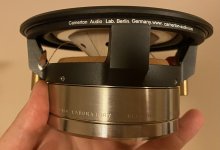 3B221C56-FC2A-4538-87CA-143B1C056965.jpeg343.6 KB · Views: 117
3B221C56-FC2A-4538-87CA-143B1C056965.jpeg343.6 KB · Views: 117 -
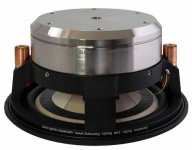 34702E34-4082-4527-8F6C-52EEB669ED51.jpeg34.9 KB · Views: 111
34702E34-4082-4527-8F6C-52EEB669ED51.jpeg34.9 KB · Views: 111 -
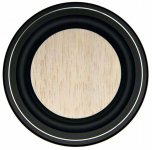 A49C6CDE-638B-432A-A8E9-C65D89646691.jpeg82.1 KB · Views: 112
A49C6CDE-638B-432A-A8E9-C65D89646691.jpeg82.1 KB · Views: 112 -
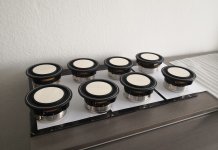 C4A8694B-DDEA-479D-8C57-E74207AB0527.jpeg329.5 KB · Views: 114
C4A8694B-DDEA-479D-8C57-E74207AB0527.jpeg329.5 KB · Views: 114 -
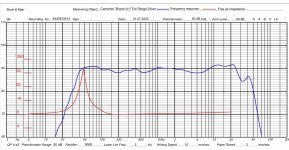 B311D57E-B0C6-49EF-90F2-347FAED9C10E.jpeg355.6 KB · Views: 122
B311D57E-B0C6-49EF-90F2-347FAED9C10E.jpeg355.6 KB · Views: 122 -
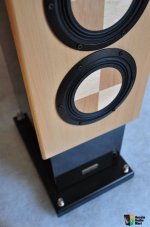 7AE2E3CD-D065-4AF9-9BD9-B447E0C70811.jpeg45.9 KB · Views: 122
7AE2E3CD-D065-4AF9-9BD9-B447E0C70811.jpeg45.9 KB · Views: 122 -
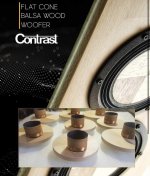 BF248572-FBF2-4753-A727-8A06846E9F86.jpeg146.6 KB · Views: 114
BF248572-FBF2-4753-A727-8A06846E9F86.jpeg146.6 KB · Views: 114
Hi ChristianHello Eucy
Very nice styling and looking... quite complex design also. I understand it is difficult to know how to move on. Many phenomena involved.
When you will have time, some sketches?
Just a question for now : what is the material of the half pipe on the sides? how the panels are attached to it?
Christian
The half tubes are treated cardboard.
The panels are glued to the tube edges with a 5mm overlap. Quite a tricky assemble.
Eucy
HereI apreciate your enthusiasm in research! Can you post NXT paper where they mention angled cutting on the membrane?
The strangest thing is that the majority of those, who contributed to NXT inventions had grown out of it. 🙂
Last edited:
NoIn the side tubes, you have 4 rectangular holes on each side. Are they for bass-reflex?
No.. Only on the rear ventIf so, is there a way to close the holes on one side (#8,733) temporarily to check how the sound reacts to that? Also, have you put any damping on the back wall?
That's the ideaThe springy half tube might be a problem, even though it looks stunning.
The tube also plays as a curved DM panel. In a way, you have two large DM panels, and two curved DM panels.
I regularly doAlso, what if you turn off the back panel thruster,
No.. That goes against the whole ideaand block that panel's movements?
It's assisting the frontJust thinking, if you are not going to place the Viridian in the centre of the room, you don't really need the back panel as a DM panel.
Nup..(Shakin’ All Over https://g.co/kgs/oQtGtY)More or less, you'd want it silent. In a way, your creation doesn't have a single stiff section/part to hold the other DM parts, that is, if you don't have a structure inside holding everything. Just tinking.
Last edited:
No problem I see except that your thinking in the box again... No difference from your vase or cylinder experimentI suppose, that's the problem. 🙂
If you are happy with your creation, that's all that matters. 🙂No problem I see except that your thinking in the box again... No difference from your vase or cylinder experiment
It is interesting that those companies that still trying produce DM loudspeakers actually use NXT findings and inventions. They sometimes write their own patents, but what's new in them is some cosmetic changes, or few different materials, or change of exciter placing or the amount of exciters or something of sort. But, they are all boxed, one way or another, and have some kind of grill at the back. For example,
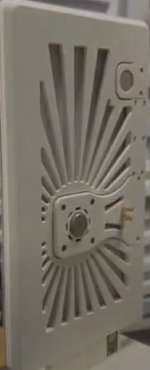

Last edited:
- Home
- Loudspeakers
- Full Range
- A Study of DMLs as a Full Range Speaker

